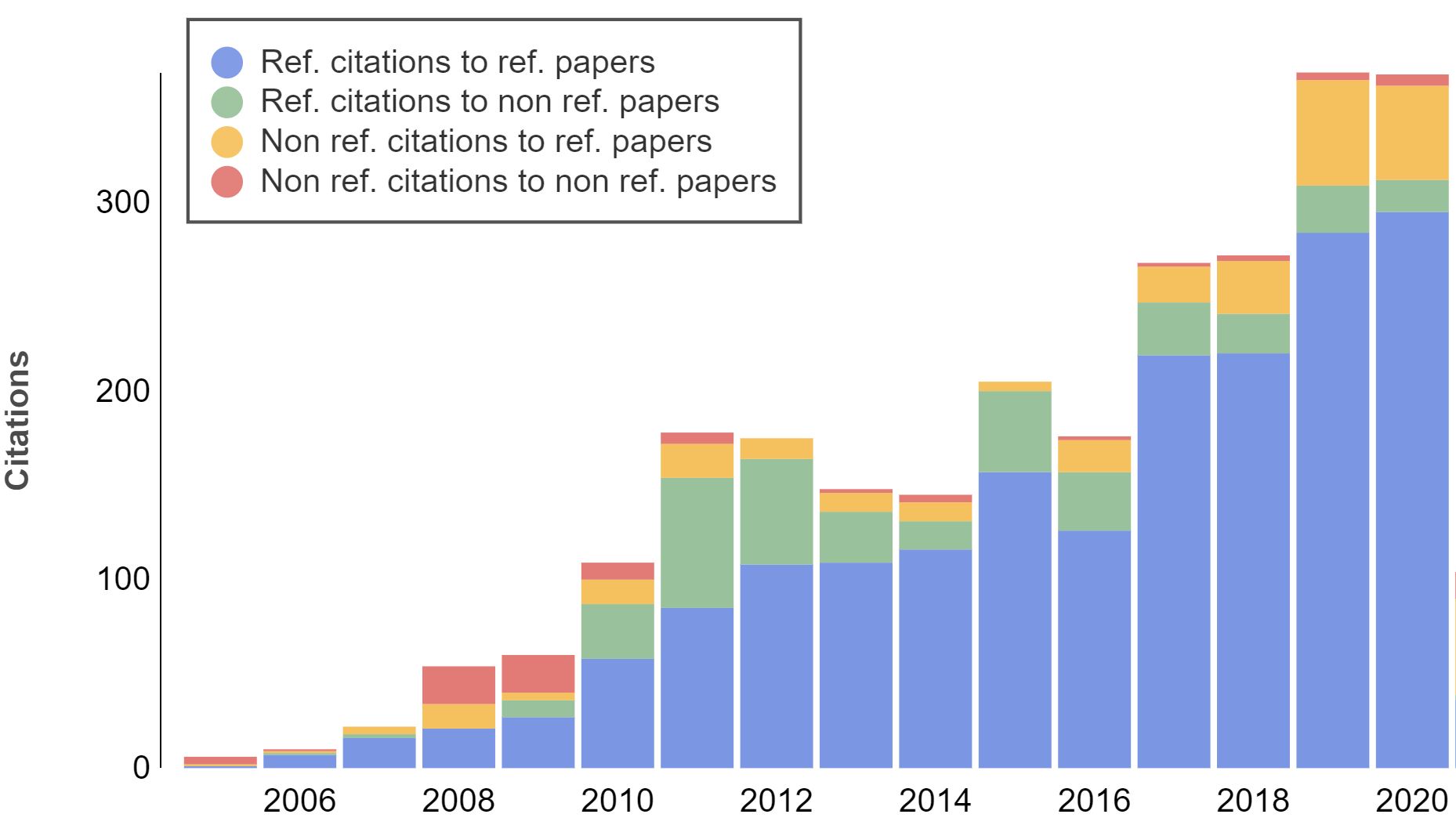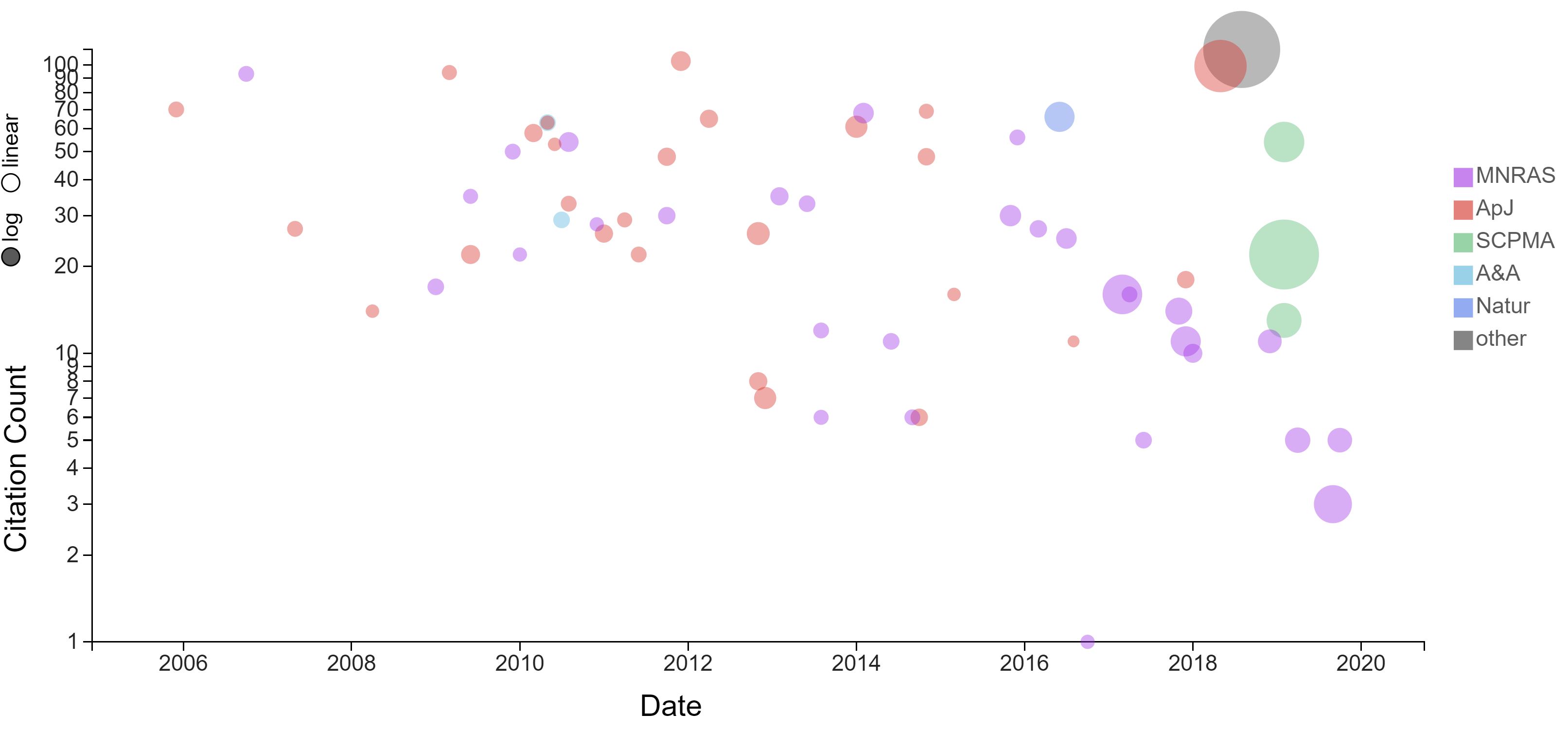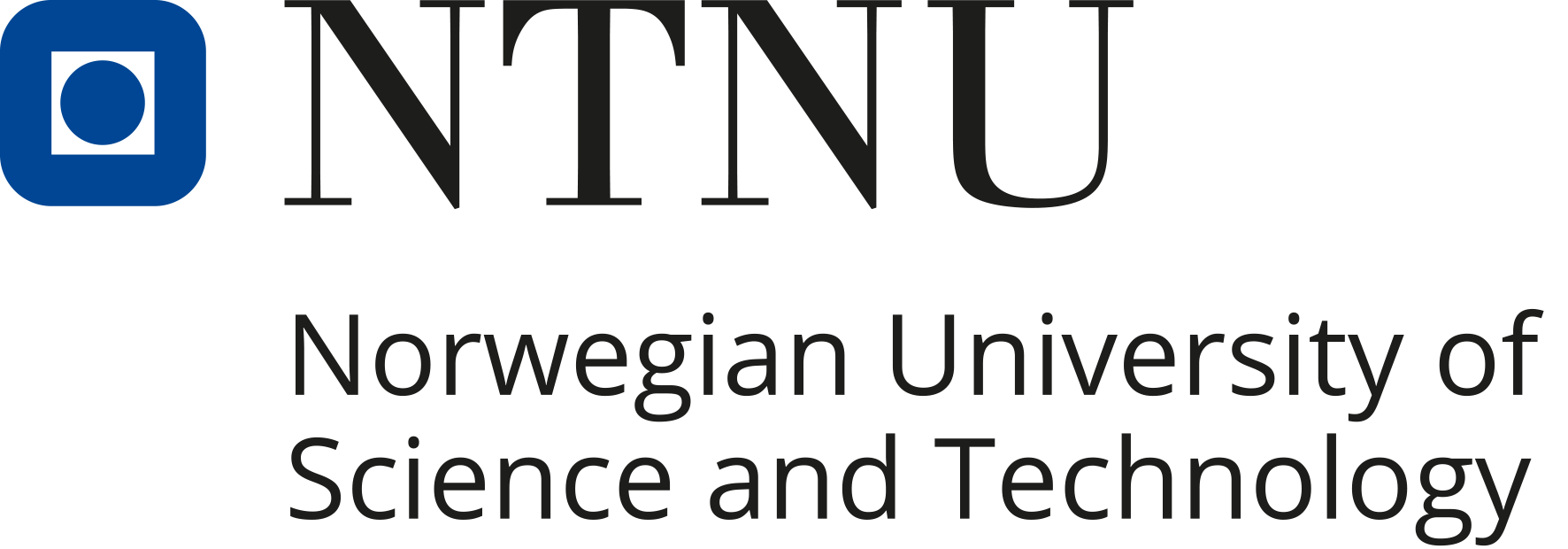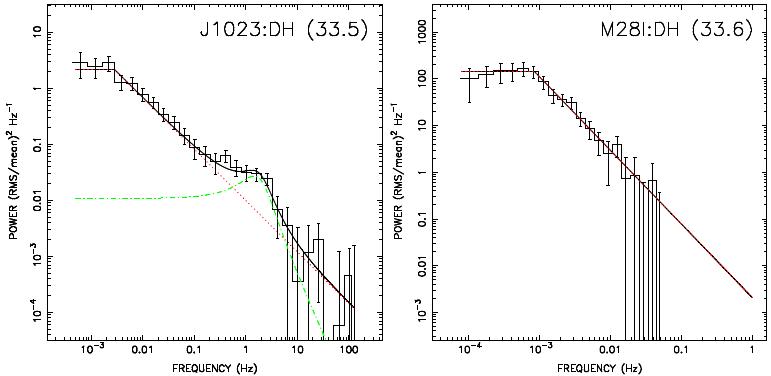
MANU LINARES
NTNU & UPC - Astrophysics
Neutron stars, black holes and white dwarfs:
compact objects are fascinating astronomical objects
and laboratories for extreme physics.
My research field is high-energy astrophysics
with a main focus on compact objects in binary systems,
neutron stars and accretion flows.
News and views
 LATEST NEWS:
LATEST NEWS:(click on the images for details)

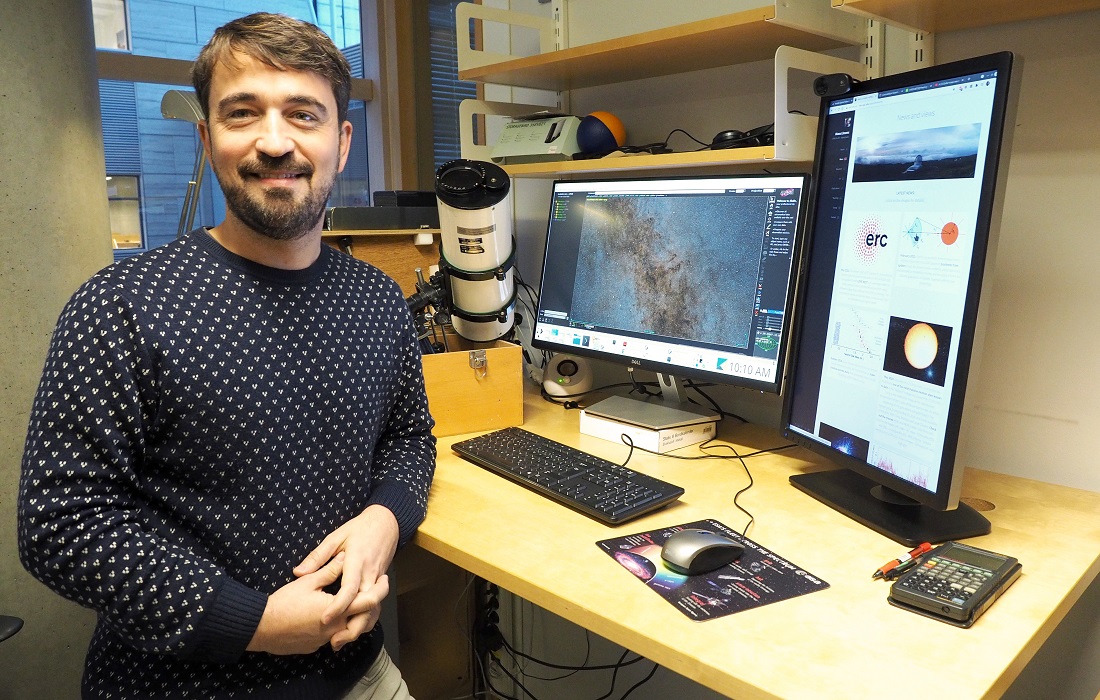
December 2021: A "Christmas tale" or outreach article about the wonders, lives and deaths of neutron stars, published on December 22nd in Gemini/Norwegian SciTech News: hunting for dead stars. Written by Steinar Brandslet. See also (in Norwegian): forskning.no/tu.no.

May 2021: Our project LOVE-NEST: Looking for Super-Massive Neutron Stars has been funded with a 2-M-EUR H2020 ERC Consolidator Grant! LOVE-NEST is a 5-year team effort to study compact binary millisecond pulsars from many different angles, that I will lead from NTNU in Norway.
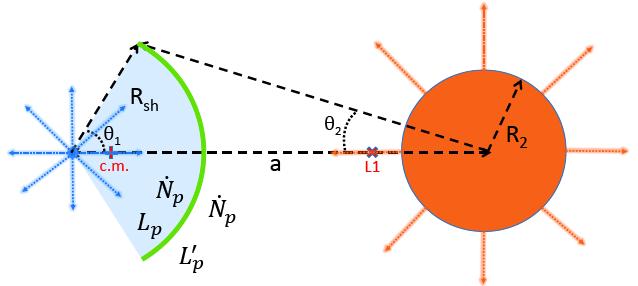
February 2021: Cosmic ray positrons from compact binary millisecond pulsars. Our JCAP paper on positrons from spiders is out! We present a new model for pulsar positrons reaccelerated in intrabinary shocks, and we apply it to the full Galactic population of spiders. See this talk at ICRC where I summarize the model and results. Together with Michael Kachelriess.
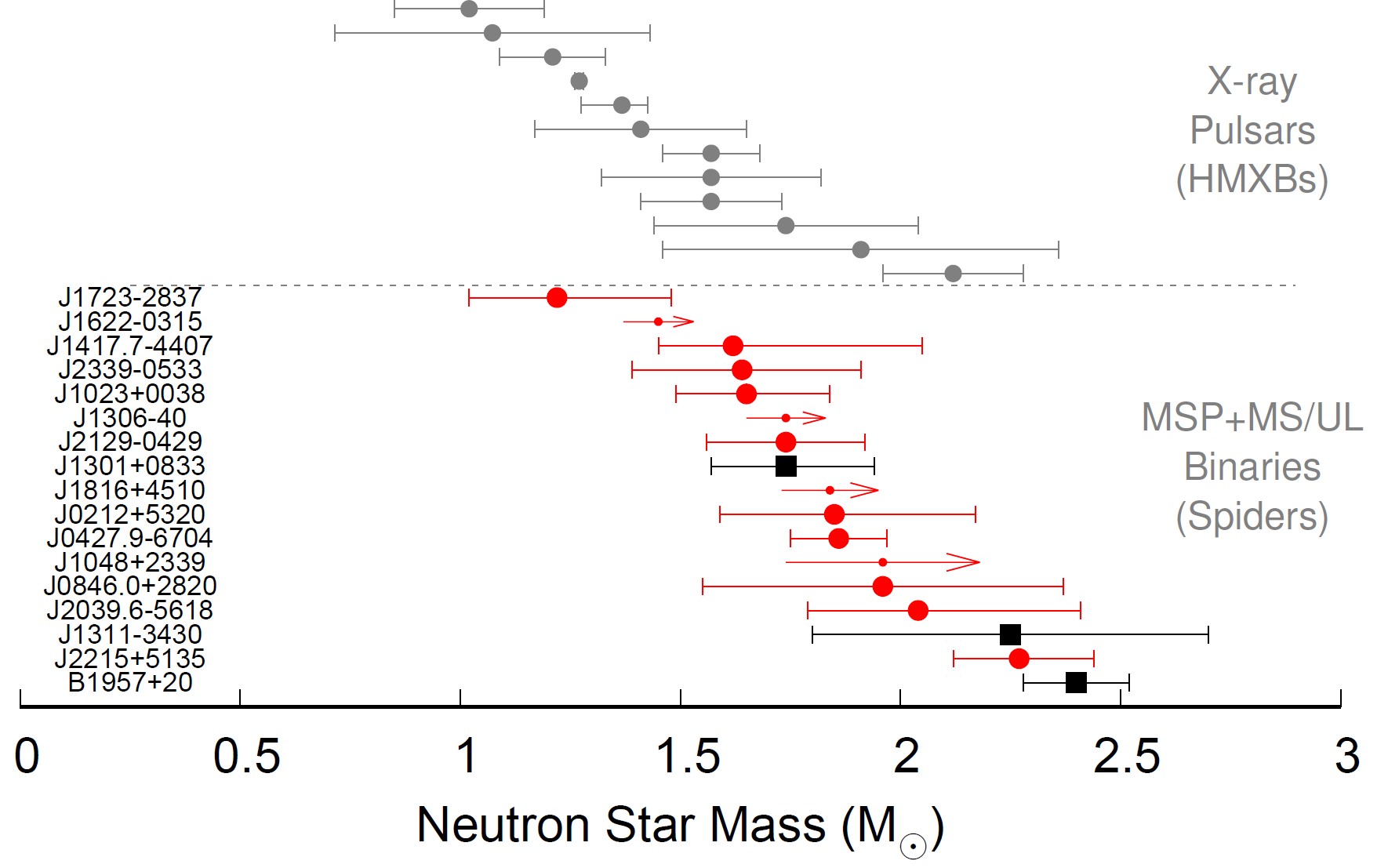
October 2019: Super-massive neutron stars and compact binary millisecond pulsars. An invited review on super-massive neutron stars, that I presented at the Frascati Workshop 2019 in Palermo, Italy.
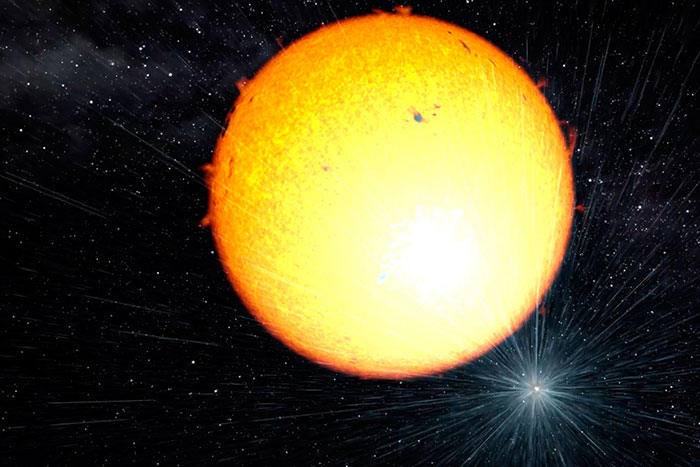
May 2018: Discovery of a 2.3 Solar-mass neutron star! We have found one of the most massive neutron stars known to date in the "redback" millisecond pulsar PSR J2215+5135, using a new method to measure the velocity (and temperature!) of both sides of the companion star. An article explaining all the gory details was published in The Astrophysical Journal on May 23, 2018, and is also available on the arXiv. With: Tariq Shahbaz and Jorge Casares. Check out the movies HERE and HERE (Credit: Gabi Perez/IAC). J2215 in the media: UPC news - IAC news - El Periodico (ES) - ABC (ES) - La Vanguardia (ES) - RNE/24horas - tertulia cientifica (min.25:50, ES) - Science News - Gizmodo/UK - AAS highlight
Archived news/highlights:
(click on the images for details)
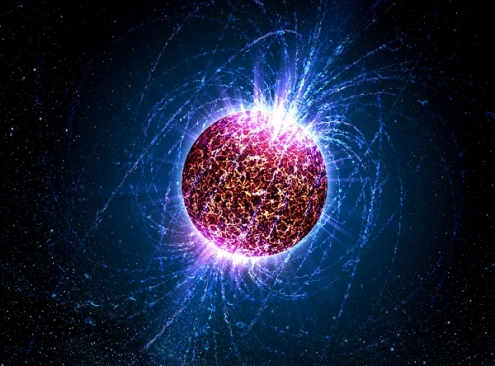
2018: Take a walk on the wild side of the Galaxy. A public (beer-in-hand) outreach talk at an Irish pub on how to resuscitate neutron stars, together with my old buddy Miquel Sureda, within the Pint of Science festival. Slainte!
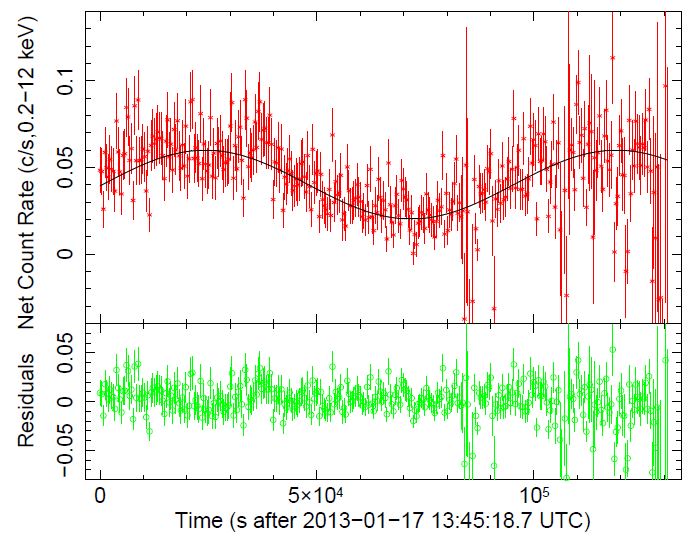
2018: Discovery of the optical & X-ray counterparts and the orbital period of PSR J1306-40. Looking back at archival X-ray and optical observations of this newly discovered millisecond pulsar, I showed that the flux in both bands is modulated with the same 1.09716 days period. Thus I established this as a new compact binary millisecond pulsar, with one of the longest orbital periods among such systems.

2017: Dynamical modelling of the new redback pulsar candidate 3FGL J0212.1+5320: asymmetric optical light curves and evidence for a massive neutron star. Together with Tariq Shahbaz and Rene Breton, we modelled the fluxes and radial velocities of the companion star to this new redback millisecond pulsar candidate. We were able to reproduce the clearly asymmetric optical light curves, and found evidence for a 1.85 Solar-mass pulsar (undetected as of yet).
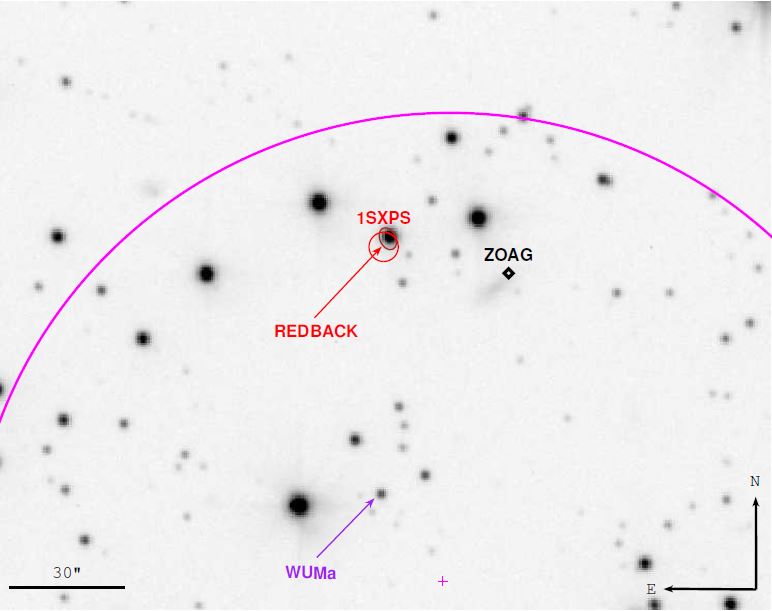
2017: A millisecond pulsar candidate in a 21-h orbit: 3FGL J0212.1+5320. We discovered a variable optical counterpart to the unidentified gamma-ray source 3FGL J0212.1+5320, and argued that this is a new compact binary millisecond pulsar ("redback") candidate.

2017: BACCO has started! I was awarded a highly competitive Marie Curie Fellowship (reintegration grant). I will be working with Jordi José and Gloria Sala on Burning on ACcreting Compact Objects, studying thermonuclear burning on the surface of neutron stars and white dwarfs.
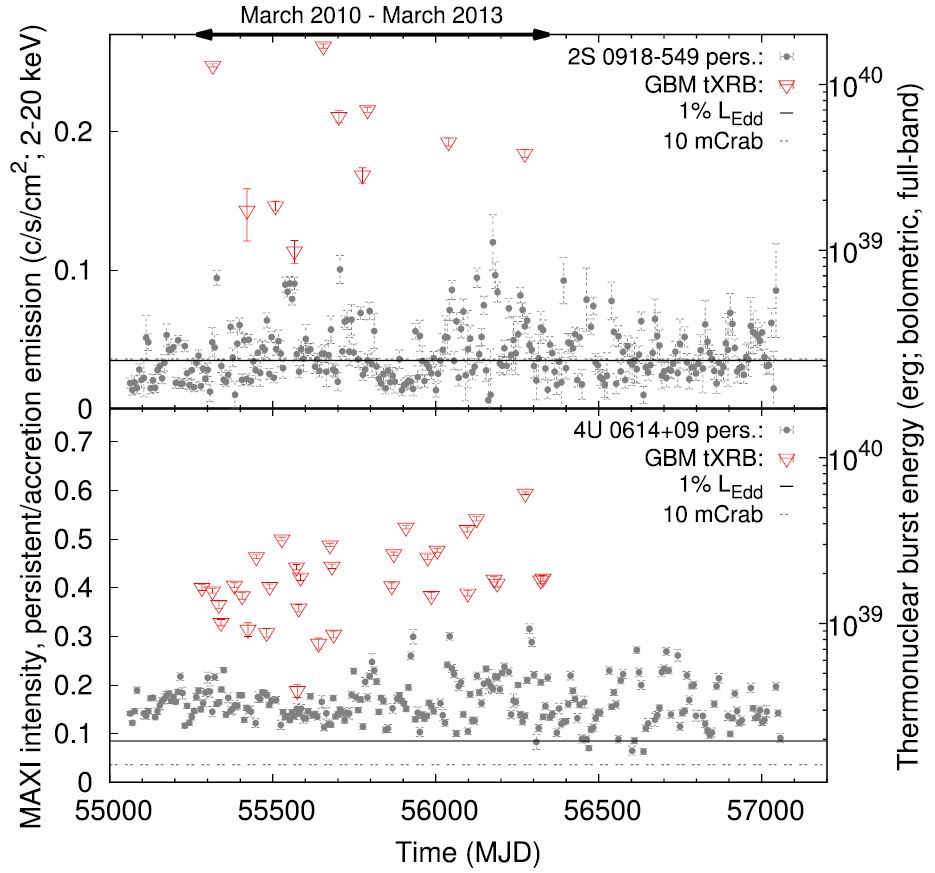
2016: The Fermi-GBM X-ray burst catalog is out! Together with Pete Jenke, Valerie Connaughton and others at UAH,. We found an average rate of 1.4 thermonuclear bursts per day, integrated over all Galactic bursters within about 10 kpc. These include 33 and 10 bursts from the ultra-compact X-ray binaries 4U 0614+09 and 2S 0918-549, respectively.
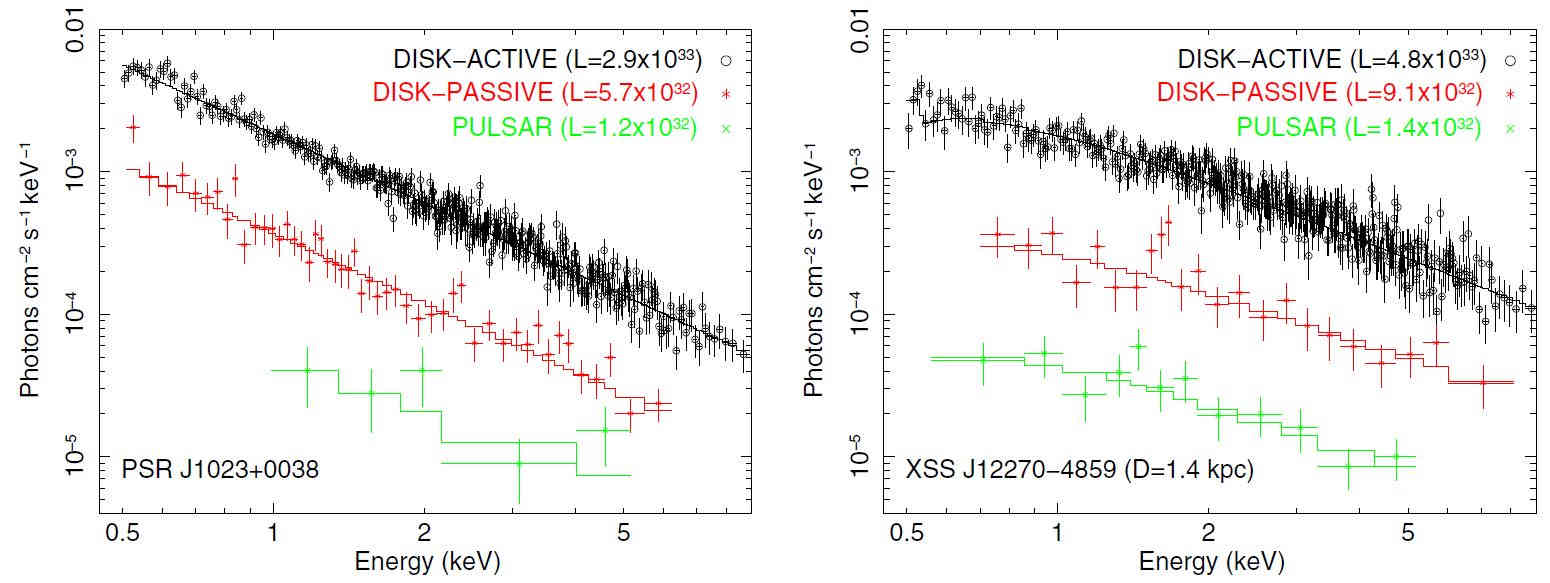
2014: X-Ray States of Redback Millisecond Pulsars. In this review of the X-ray properties of redback millisecond pulsars across six orders of magnitude in luminosity, I was the first to note that X-ray mode switching is ubiquitous in their disk state!
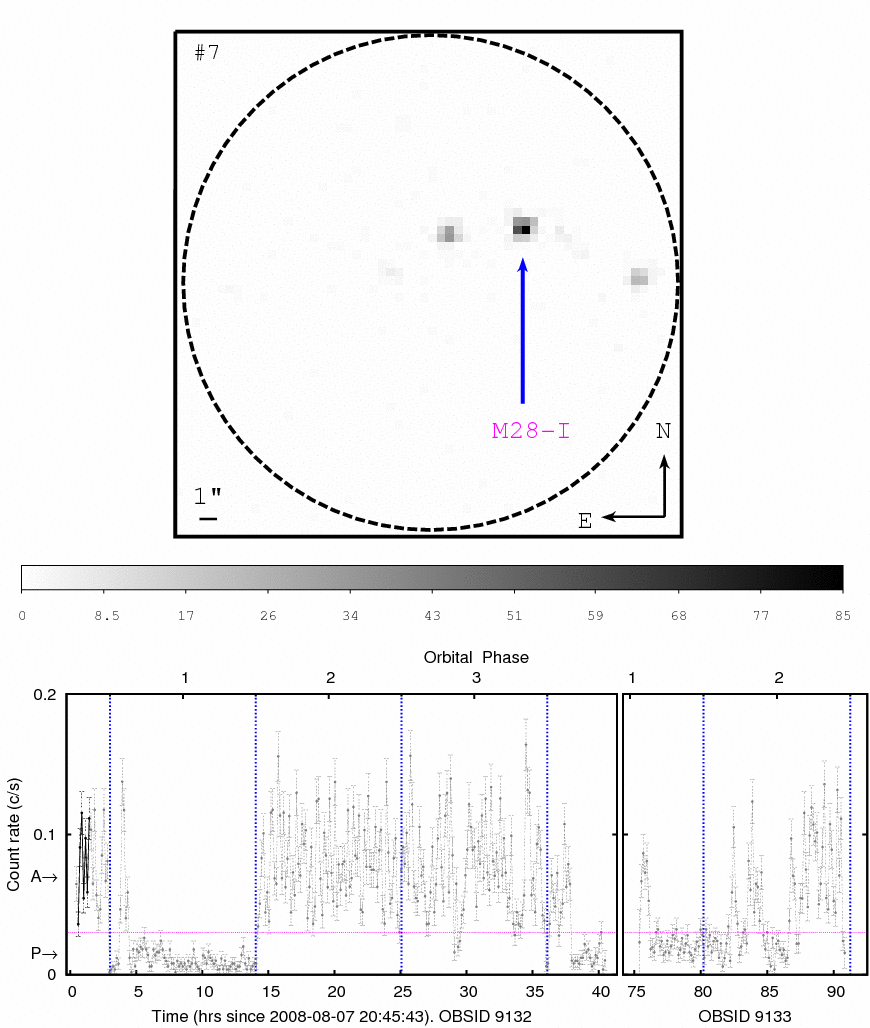
2014: M28I, from sub-luminous accretion to rotation-powered quiescence. Here is where we proposed the tug-of-war model for X-ray mode switching: a dynamic balance between the accretion flow and the pulsar wind. With: Arash Bahramian, Craig Heinke and others.
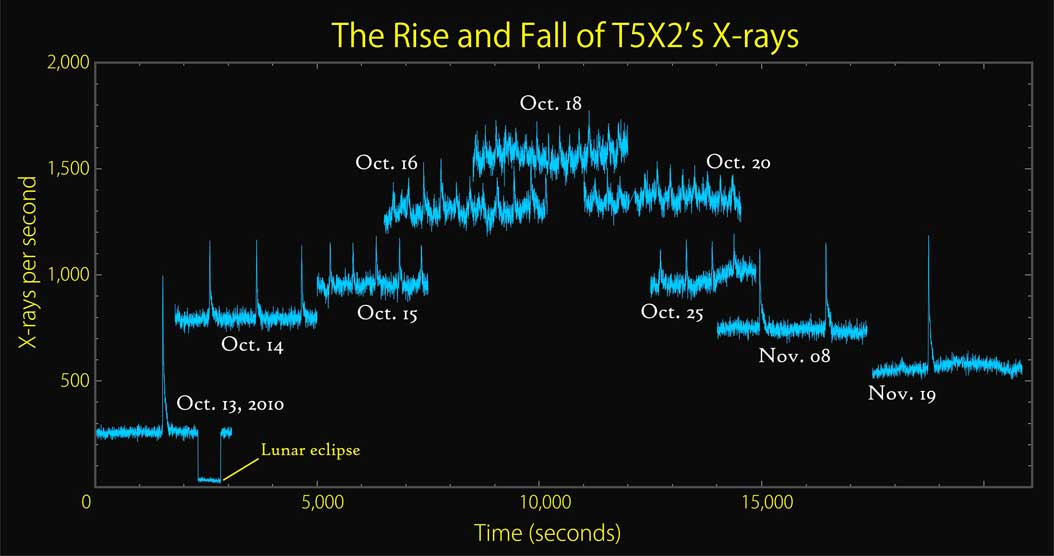
2012: Terzan 5 X-2: A showcase of thermonuclear burning regimes. With: Diego Altamirano, Deepto Chakrabarty, Andrew Cumming and Laurens Keek. T5X2 in the media: MIT news - NASA - HEASARC-PoW - Science Daily - SINC (Sp.) - ABC (Sp.)
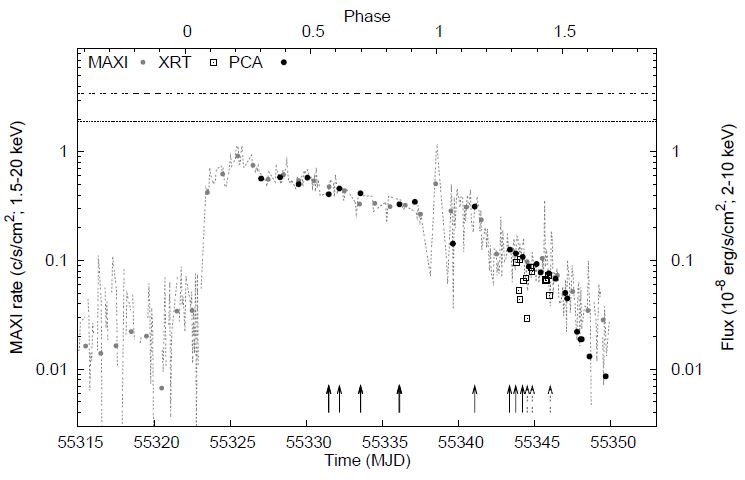
2010: The return of the bursts. Thermonuclear flashes from the peculiar X-ray binary Circinus X-1. With: Anna Watts and others.
Research
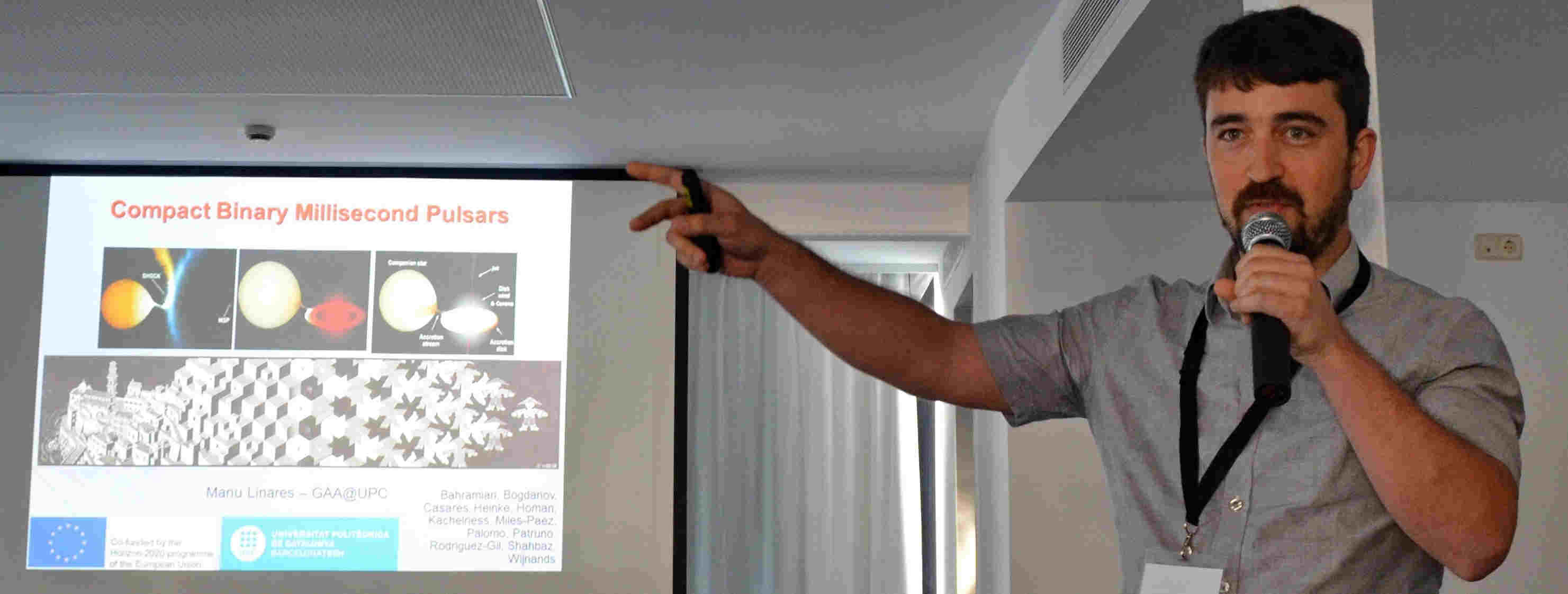
Neutron stars are cool!
Not only fascinating astronomical objects,
neutron stars are also unique laboratories for extreme physics. Just
like our planet Earth, a neutron star has an atmosphere, a solid
surface, a crust and a liquid core. Neutron stars are [4-7]x105 times
more massive than Earth, but they are densely and stably packed in a
radius of about 8-15 km. As a consequence, their surface gravity is 1011
times stronger than that on Earth. Escape velocities approach the
speed of light and even photon trajectories are severely bent in their
intense gravitational fields. Neutron stars can also have mountains,
quakes, and a large scale magnetic field, 108-1015 times stronger than
that on Earth.
More than five decades after neutron stars were
discovered, some of their properties remain largely concealed. Their
inner cores reach densities above nuclear saturation, where nucleon
interactions are ill-constrained. Learning how matter behaves at such
densities is one of the main motivations of my past, present and
future research.
The
study of neutron stars has also profound implications for numerous
fields of astronomy, including supernovae and their remnants,
gravitational waves from binary mergers, jets and accretion
flows. For all these reasons, my research is
aimed at accreting compact objects with a special focus on neutron
stars.
Resuscitating neutron stars.
Neutron stars are often considered stellar corpses,
formed after the death of a massive star in a supernova
explosion. Left alone, they cool down and decrease their rotation rate
until they cross the `death line' and cease to exist as radio
pulsars. Accretion of mass in a binary system provides a way to
resurrect them. Thanks to the in-falling gas stripped from the
outermost layers of a nearby star, neutron stars in the so-called
low-mass X-ray binaries release tremendous amounts of energy, mostly
in the X-ray band. They also regain their nuclear energy, becoming
thermonuclear reactors on the surface, and a handful of them are seen
as accreting millisecond pulsars (showing accretion-powered
millisecond X-ray pulsations). Moreover, the accretion of angular
momentum from the innermost gas spins up or `recycles' those neutron
stars, decreasing their spin periods to just a few milliseconds. This
allows them, once accretion stops, to become active again as
rotation-powered millisecond radio pulsars.
In the following I summarize my three main lines of research which I like to divide, according to the energy source, in three broad types of phenomena: those powered by the rotational energy of the neutron star; those powered by nuclear reactions in the neutron star envelope; and those powered by the gravitational energy released by the accretion of mass onto the neutron star.
ROTATION POWER: A lighthouse in the wind
The
launch of the Fermi Gamma-ray Space Telescope triggered
remarkable neutron star discoveries, which have uncovered
a new population of millisecond pulsars in compact binaries.
In these tight binaries, with orbital periods shorter than about a day, the intense
relativistic pulsar wind (powered by the rotational energy reservoir of the neutron star)
can strongly irradiate or even ablate the companion star.
This growing nearby population of pulsars offers a new opportunity to measure the masses of recycled neutron stars.
Furthermore, a handful of rapidly spinning, low magnetic field neutron stars are now seen to alternate between
accretion-powered and rotation-powered states (the so-called "transitional millisecond pulsars").
These recent findings have confirmed the evolutionary link between
millisecond radio pulsars (MSPs) and low-mass X-ray binaries, and have opened a new era where the metamorphosis of a
neutron star from a rotation- to an accretion-powered state (and vice versa) can be directly observed!
[See Duncan Lorimer's updated list of Galactic MSPs.]
[See Paulo Freire's list of pulsars in globular clusters.]
FOR MORE:
Here is the talk on positrons from spiders that I gave at the ICRC 2021 in July 2021
THERMONUCLEAR POWER: The ticking bomb
The plasma accreted onto neutron stars piles up until nuclear reactions become thermally unstable and
trigger a thermonuclear runaway, which burns the accumulated fuel. This produces recurrent, sudden, bright bursts
of X-rays: thermonuclear bursts. One fundamental prediction of thermonuclear burst models clashed with
observations for over thirty years: we expect more frequent bursts when the mass accretion rate on the neutron star
increases, but little or no bursts were seen at high mass accretion rates, where helium burning should still be unstable.
In 2010, we proposed a solution to this puzzle, thanks to a slowly spinning
neutron star discovered in the globular cluster Terzan 5 (T5X2). Thermonuclear bursts from this particular system
behaved like theory predicts! Based on the unusually slow spin of T5X2, we argued that rapid rotation has a drastic effect on the
stability of thermonuclear burning in all other bursters.
ACCRETION POWER: Strong gravity rules
Accreting
neutron stars shine more than anything else in the X-ray sky (our
nearby Sun aside), thanks to the efficient conversion of gravitational
potential energy into radiation that takes place in the accretion
disc. Theories of gravity make falsifiable predictions in the strong
field regime, such as the presence of an innermost stable circular
orbit or the existence of relativistic nodal precession. Studies of
rapid X-ray variability can test these predictions, probing the
vicinity closest to neutron stars and black holes, where dynamical
timescales are as short as milliseconds.
FOR MORE:
Here is the talk I gave at the Institute for Astrophysics of the Canaries back in May 2013
LINKS TO RESEARCH PROJECTS/WEBS:
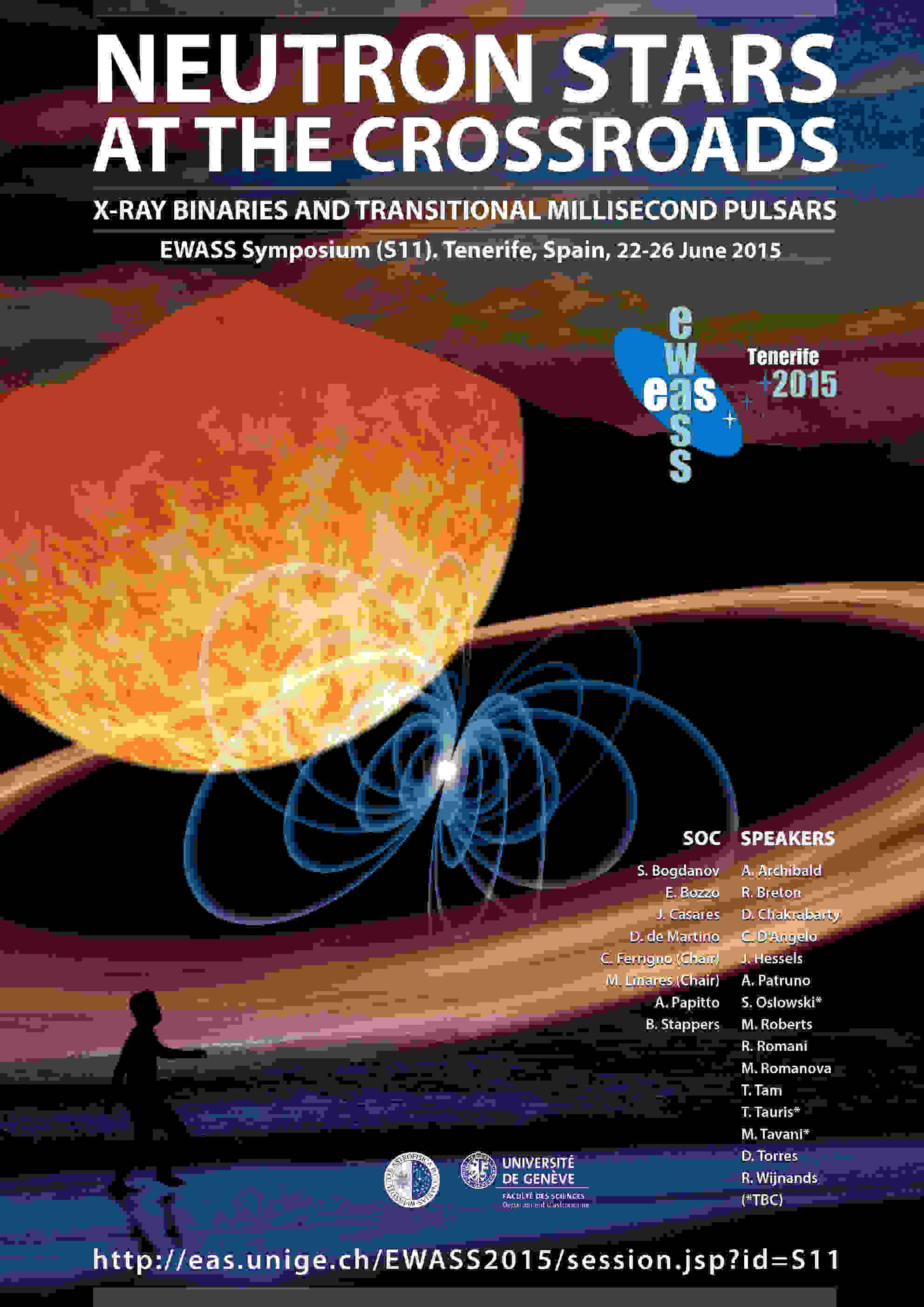
EWASS 2015: "Neutron stars at the crossroads: X-ray binaries and transitional millisecond pulsars". Program, talks and posters from our Symposium at the European Week of Astronomy and Space Science (Tenerife, Spain, June 25-26, 2015). Chairs: Manu Linares and Carlo Ferrigno.
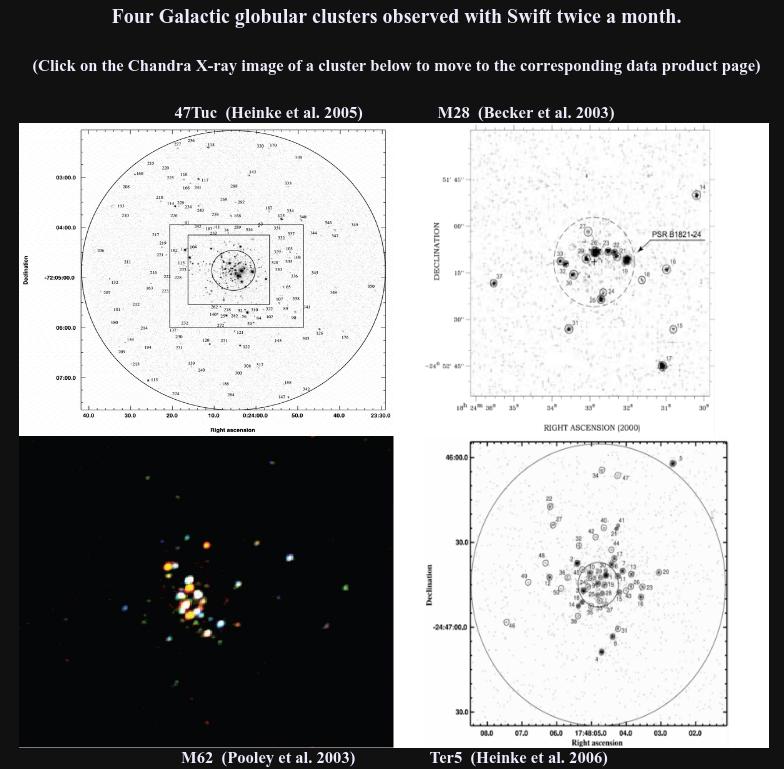
Swift-XRT Globular Cluster Monitor. Swift-XRT monitoring of selected GCs in order to: i) find new low-luminosity transient LMXBs, ii) detect short and faint outbursts from known transient NS LMXBs and iii) monitor the X-ray activity of the known MSP population to search for more MSP-LMXB transition pulsars. PIs: Manu Linares and Jerome Chenevez.
Curriculum Vitae
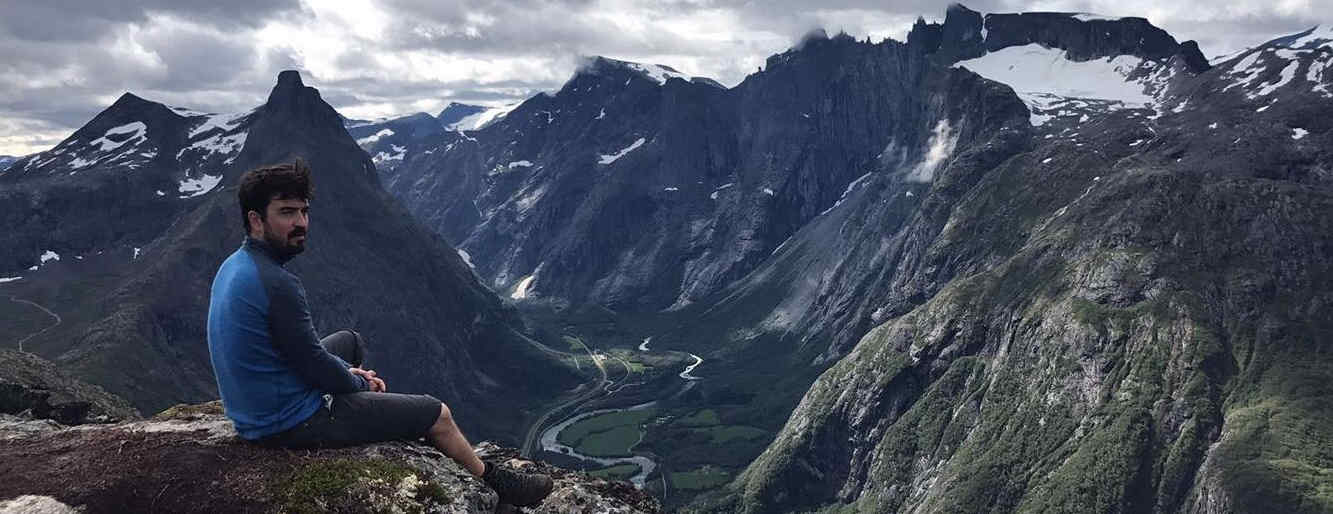
- Professor. NTNU, Department of Physics (Trondheim, Norway). From September 2021
- Associate Professor. UPC, Department of Physics (Barcelona, Spain). 2018-present
- Marie Curie Fellow. UPC, Group of Astronomy and Astrophysics (Barcelona, Spain). 2017-2018
- IAC Fellow. Instituto de Astrofísica de Canarias (Tenerife, Spain). 2012-2017
- Rubicon Fellow. Massachusetts Institute of Technology (Cambridge, US). 2009-2012
- PhD in Astronomy. Universiteit van Amsterdam. (Amsterdam, The Netherlands). 2004-2009
- Physics Degree. Universitat de Barcelona (Barcelona, Spain). 1998-2004
Publications

I have authored more than 70 refereed articles in high-impact journals (Nature, ApJ, JCAP, MNRAS, A&A), 15 of them as first and lead author. My publications have received more than 3500 citations and form an h-index of 33 (Upd: Feb.2024).
For the non-specialized public: see our outreach article in Investigacion y Ciencia (the Spanish edition of Scientific American; link in ES).
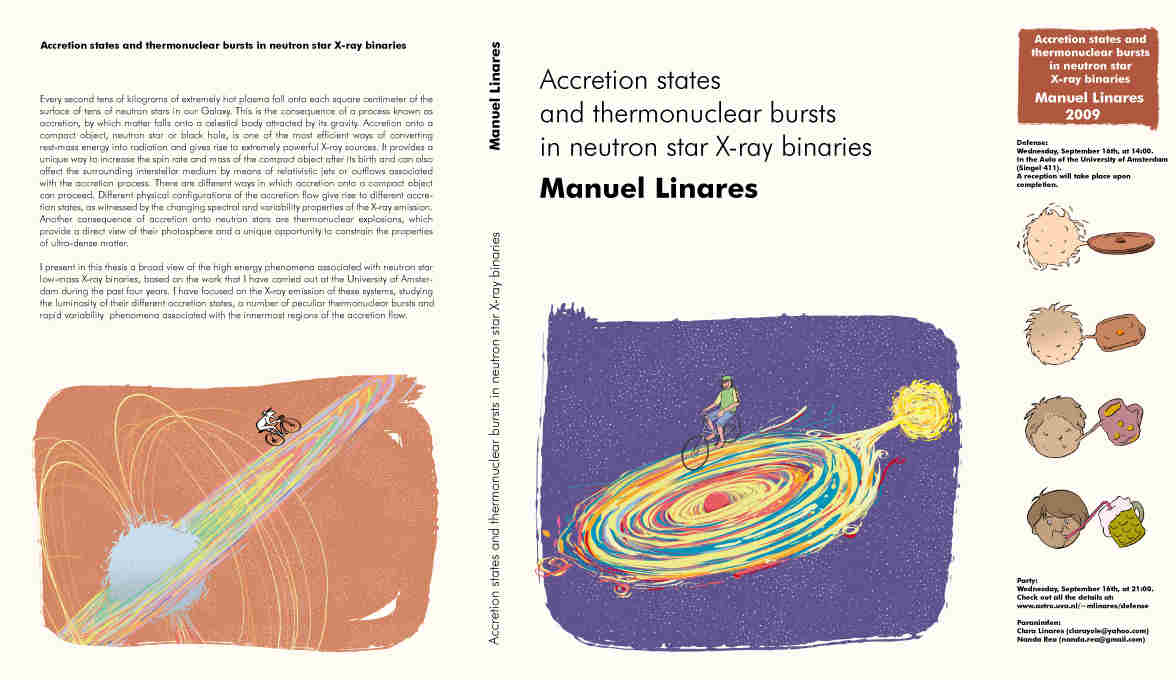
Dissertation: I defended my PhD thesis on 2009-09-16 at API-UvA, with Michiel van der Klis as my advisor. You can download the full book here.
Because these numbers evolve rapidly, next you can find links to updated lists of my publications.
Updated full publication lists:NASA-ADS G-Scholar ORCID
Subsets/sorted lists:
ADS (refereed) ADS (1st. author) ADS (by citations)
Others:
SCOPUS (beta) CRISTIN (beta)
Teaching
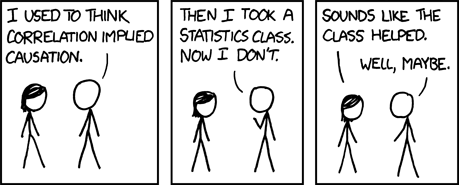
-
Observational Astrophysics (FY3215).
Lectures, Planetarium, Astro-LAB sessions and Observing Project: Manu Linares
First year M. Sc. course, Physics/Applied Physics & Math.
Norwegian University of Science and Technology, 2022-.
Invited School Presentation, NOT (YouTube). Download poster:
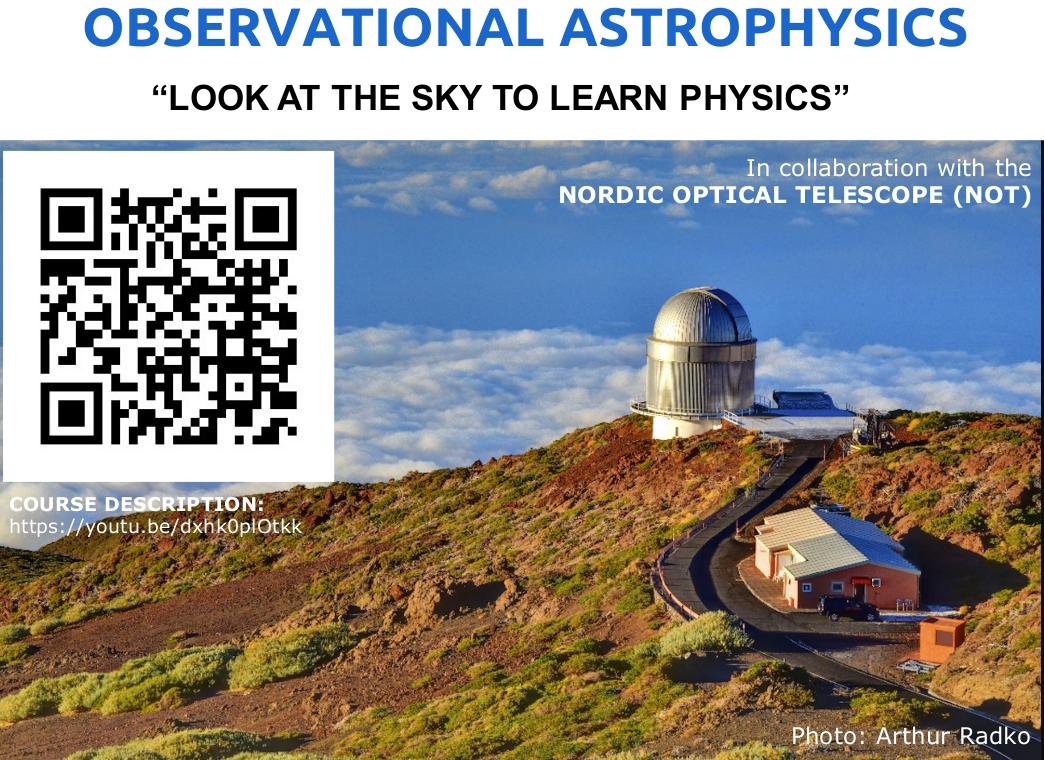 Course calendar (L:lecture, P:problems, P5:astrolabs, GL:guest lecture, OP:observing project):
Course calendar (L:lecture, P:problems, P5:astrolabs, GL:guest lecture, OP:observing project):
-
Space Technology I (TTT4234).
Guest Lecture on "Astronomical observations from space".
Course coordinator and main lecturer: Vendela Maria Paxal
First year M. Sc. course, Department of Electronic Systems, Electronic Systems Design.
Norwegian University of Science and Technology, 2023-.
-
Quantum Physics (UPC-EF-Q3-2A-FISQ).
Lectures: Manu Linares and Jordi José.
Second year B. Sc. course, Eng. Physics.
Polytechnic University of Catalonia, 2017-2021.
DOWNLOAD (old-school) LECTURE NOTES, HYDROGEN ATOM:
*Time-independent Schroedinger equation in 3D.
*Orbital angular momentum in the one-electron atom.
*Magnetic dipoles, spin and spin-orbit coupling.
-
Physics I: Fundamentals of Mechanics (UPC-EEBE-Q1-F1FM).
Lectures and Lab sessions.
First year B. Sc. course, Engineering Degrees.
Polytechnic University of Catalonia, 2018-2021.
Here is the talk on "Teaching Observational Astrophysics with the NOT" that I gave at the NOT workshop in June 2022
Group of Astronomy and Astrophysics (GAA)

-
Current/former group members and students:
- Eda Vurgun (Ph.D. Candidate, 2020-2024)
- Triantafyllos Kormpakis (Ph.D. Candidate, 2024-2027)
- Carlos Celma (B.Sc. Thesis, 2019. Now at: ING, La Palma)
- Marta Rubio (B.Sc. research project, 2018. Now at: DTU, Copenhagen)
- Laura Portos, Andrea Valenzuela (B.Sc. research project, 2017. Now at: UU, Utrecht; AI, UPC)
We always welcome motivated hard-working students and highly qualified researchers to work in our group. See the following (incomplete list of) funding opportunities and research projects, and contact us if you are interested in joining the GAA!
- Ramon y Cajal (Senior tenure-track 5-yr fellowships, Spanish funding; link in ES)
- Beatriz Galindo (Senior/junior tenure-track 4-yr fellowships, Spanish funding; link in ES)
- Marie Curie (Highly competitive 2-yr fellowships, European funding)
- Beatriu de Pinos (Postdoctoral 2-yr fellowships, Catalan funding)
- La Caixa junior leader (Postdoctoral 3-yr fellowships, private funding)
- Juan de la Cierva (Postdoctoral 2-yr fellowships, Spanish funding; link in ES)
- PHAROS STSM (COST Action funds for short visits, 5-90 days)
- ChETEC STSM (COST Action funds for short visits, 5-90 days)
- Ph.D. Thesis grants. FI (Catalan funding) - FPU (Spanish funding) - La Caixa (PhD fellowships)
- M.Sc./B.Sc. Thesis projects in Engineering Physics (TFG/TFM)
- M.Sc./B.Sc. Thesis projects at EEBE (TFG/TFM)
Credit: Jordi José
An overview of some of our research lines:
Astrophysics and Particle Physics Group (APP)

LOVE-NEST: Looking for Super-Massive Neutron Stars
We have been awarded a 2M-EUR H2020 ERC Consolidator Grant: LOVE-NEST (PI: M. Linares). The purpose of this project is to find the most massive neutron stars and to understand the interaction between accretion flows, pulsar winds and neutron star magnetospheres. LOVE-NEST will uncover a hidden population of millisecond pulsars, with a targeted search of gamma-ray candidate sources. We will measure accurately the masses of the heaviest pulsars, using a novel technique that we have recently established. We will also investigate nearby spiders as potential sources of cosmic rays and astrophysical neutrinos, placing unprecedented constraints on particle acceleration in relativistic pulsar wind shocks.
I often have MSc thesis projects for motivated and hard-working NTNU students, with some previous experience/courses in astrophysics. See this (likely incomplete) list of research projects, this information from the Department of Physics and contact me if you are interested and fulfil the above description.
-
Current/former group members and students:
- Karri Koljonen (Postdoctoral Fellow, 2022-2026)
- Devina Misra (Postdoctoral Fellow, 2022-2026)
- Vittoria Vecchiotti (Postdoctoral Fellow, 2022-2026)
- Raphael Mignon-Risse (Postdoctoral Fellow, 2022-2026)
- Marco Turchetta (Ph.D. Candidate, 2022-2026)
- Bidisha Sen (Ph.D. Candidate, 2022-2026)
- Jordan Simpson (Ph.D. Candidate, 2022-2026)
- Maksat Satybaldiev (Ph.D. Candidate, 2022-2026)
- Triantafyllos Kormpakis (Ph.D. Candidate, 2024-2027)
- Sindre Lindseth (M.Sc. Thesis, 2023. Now at: UQ Brisbane, Australia)
- Anders Tidemann (M.Sc. Thesis, 2023. Now at: Vitensenteret, Trondheim)
- Iacob Nedreaas (M.Sc. Thesis, 2024. Now at: Vitensenteret, Trondheim)
For more details on the ERC project, job ads and team members, please see:
THE LOVE-NEST WEBSITE .
Credit:
Bogdan Voaidas
Astro & Theory seminar
Astro & Particle journal club
APP GROUP WEBSITE
Credit: Michael Kachelriess
Contact

Department of Physics (IfY)
Norwegian University of Science and Technology (NTNU)
Address:
NTNU - Gloshaugen - Department of Physics
Høgskoleringen 5, Realfagbygget (Office D5-125)
NO-7491 Trondheim, Norway.
Phone:
+47 73592206
E-mail:
manuel.linares@ntnu.no
Skype:
manulinares
Map by MazeMap

GAA - Group of Astronomy and Astrophysics
Barcelona East School of Engineering (EEBE)
Polytechnic University of Catalonia (UPC) - BarcelonaTech
Address:
UPC-EEBE,
Av. Eduard Maristany 16 (Office C2.22)
08019 Barcelona, SPAIN.
Post:
Sant Ramon de Penyafort 261-269
08930 St. Adria de Besos, SPAIN.
Phone:
+34 93.413.77.50
E-mail:
manuel.linares@upc.edu
Skype:
manulinares
